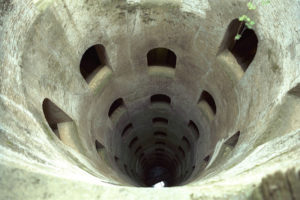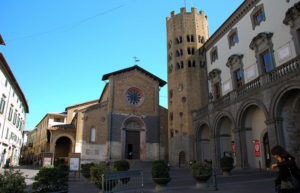

St Patrick’s Well’ has become a reference traditionally used to define a reserve boundless, or, according to others, precisely because it is boundless, ‘bottomless’, useless to fill. But the real “St Patrick’s Well” is a historic structure built by Antonio da Sangallo the Younger in the splendid city of Orvieto![]() , back in the 16th century.
, back in the 16th century.
Step after step, walking down the two helicoidal ramps, one seems to descend, as if taken by a vortex, into the heart of the earth and re-emerge, with some difficulty for the less trained, from those same bowels. In a sensation that mixes magic and curiosity, walking those fifty-four metres deep, thirteen metres in diameter, carved into the tuff, really does give the impression of descending into another dimension, with the constant temptation, to which visitors easily succumb, to count the steps. Two hundred and forty-eight steps, lit by seventy large windows and it is immediately a sacred atmosphere, immersed as one is in a deep cavity, decidedly not suitable for the claustrophobic.
But those who have been there want to return, and this is demonstrated by the custom in recent years of throwing a coin at the bottom in the hope of visiting it again.

Another well-known well is the one known as ‘della Cava‘![]() . Only thirty-eight metres deep, so to speak, it is located in a hypogeum complex of nine interconnected rooms that provide the city with fascinating sights. On the ground floor, one can find a ‘kiln’ with fragments of majolica tiles thrown in because they were defective; there are medieval wells used for throwing bones and waste, known as ‘butti’; an ‘Etruscan tomb’ transformed into a ‘follone’, a contraption for working textiles. There is also an “Etruscan cistern”, a “cellar” for storing the “wine of popes and kings”, as Orvieto’s wine was known in the Middle Ages, the “Pillar of the Tower” in the “Muffola Room” and many tunnels.
. Only thirty-eight metres deep, so to speak, it is located in a hypogeum complex of nine interconnected rooms that provide the city with fascinating sights. On the ground floor, one can find a ‘kiln’ with fragments of majolica tiles thrown in because they were defective; there are medieval wells used for throwing bones and waste, known as ‘butti’; an ‘Etruscan tomb’ transformed into a ‘follone’, a contraption for working textiles. There is also an “Etruscan cistern”, a “cellar” for storing the “wine of popes and kings”, as Orvieto’s wine was known in the Middle Ages, the “Pillar of the Tower” in the “Muffola Room” and many tunnels.
An antiquity palpable centimetre after centimetre, sigh after sigh, that coexists perfectly with contemporary trends, such as, for example, the traditional nativity scene set up each year from Christmas Eve until the Sunday after Epiphany, set up in the very last room of the Pozzo della Cava.

In short, it is a world to be discovered with passion, the one immersed in the soil of the Umbrian city that makes of its subsoil a profound wealth and feather in its cap, as is also the case of the “Church of Saints Andrew and Bartholomew “![]() , which also embodies an important reference point for city life, located in Piazza della Repubblica in the historic centre. The archaeological excavations, which can be accessed on guided tours, preserve ancient mosaic floors from the early Christian basilica, wells and even some tombs.
, which also embodies an important reference point for city life, located in Piazza della Repubblica in the historic centre. The archaeological excavations, which can be accessed on guided tours, preserve ancient mosaic floors from the early Christian basilica, wells and even some tombs.
